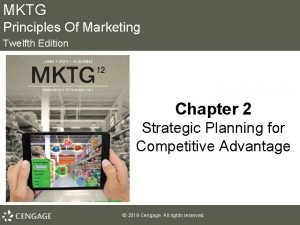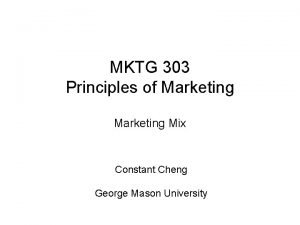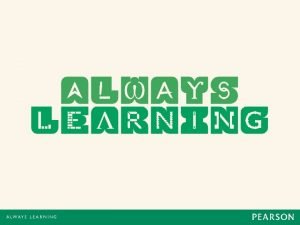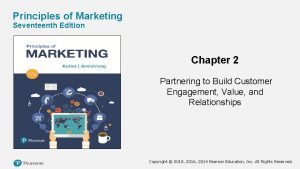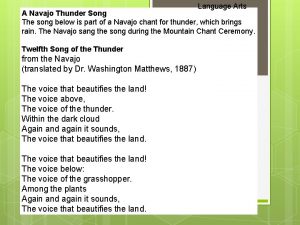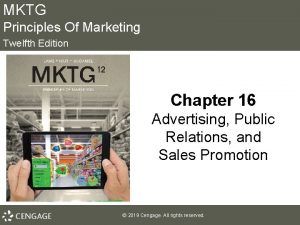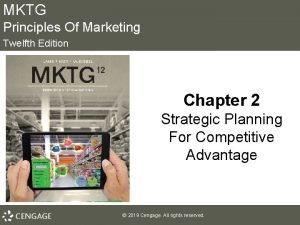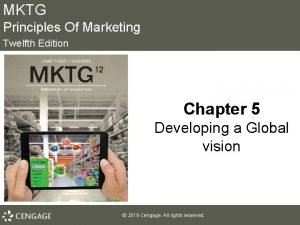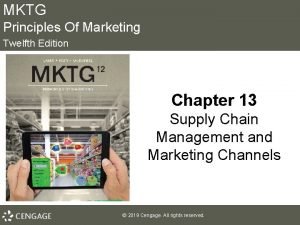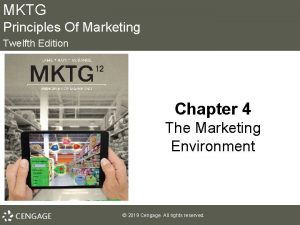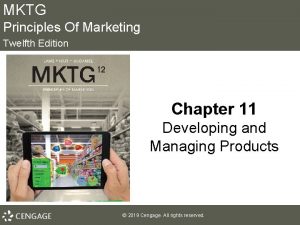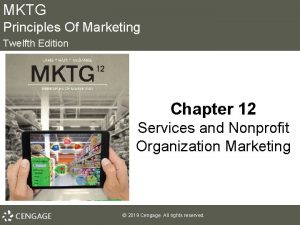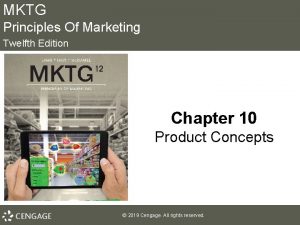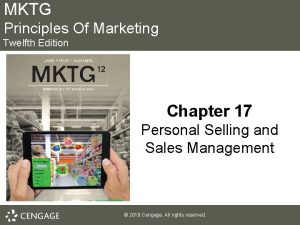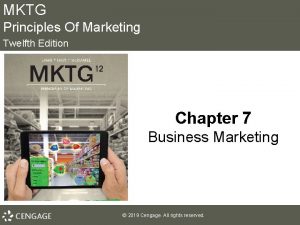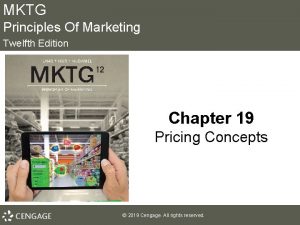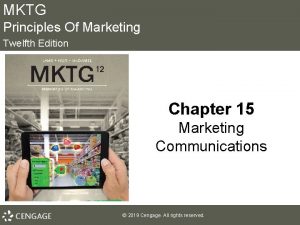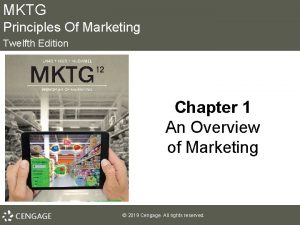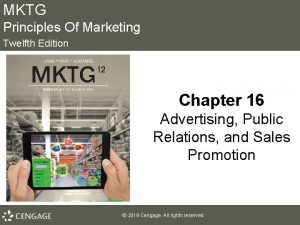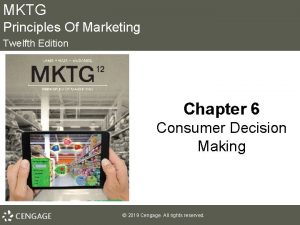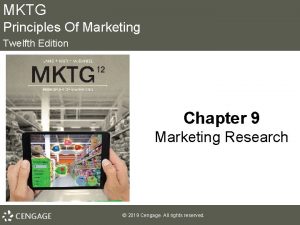MKTG Principles Of Marketing Twelfth Edition Chapter 18


























- Slides: 26

MKTG Principles Of Marketing Twelfth Edition Chapter 18 Social Media Marketing © 2019 Cengage. All rights reserved.

Learning Outcomes 18 -1 Describe social media, how they are used, and their relations to integrated marketing communications 18 -2 Explain how to create a social media campaign 18 -3 Evaluate the various methods of measurement for social media 18 -4 Explain consumer behavior on social media 18 -5 Describe the social media tools in a marketer’s toolbox and how they are useful 18 -6 Describe the impact of mobile technology on social media 18 -7 Understand the aspects of developing a social media plan © 2019 Cengage. All rights reserved.

What Are Social Media? (slide 1 of 3) • Social media: Any tool or service that uses the Internet to facilitate conversations • It can also be defined relative to traditional advertising like television and magazines, but social media offer a more one-to-one interaction with customers © 2019 Cengage. All rights reserved.

What Are Social Media? (slide 2 of 3) • Social media have several implications for marketers and the ways that they interact with their customers: – Marketers must realize that they often do not control the content on social media sites – The ability to share experiences quickly and with such large numbers of people amplifies the impact of word of mouth in a way that can affect a company’s bottom line – Social media allow marketers to listen – Social media provide more sophisticated methods of measuring how marketers meet and interact with consumers than traditional advertising does – Social media allow marketers to have much more direct and meaningful conversations with customers © 2019 Cengage. All rights reserved.

What Are Social Media? (slide 3 of 3) • Social media have changed how and where conversations take place, globalizing human interaction • Companies are also beginning to understand the implications of their employees’ activities on social media © 2019 Cengage. All rights reserved.

How Consumers Use Social Media • It is important for marketers to understand which social media consumers are using and how they are using them – Young adult singles use Match. com, Ok. Cupid, and Tinder – Teens use Snapchat, Instagram, Twitch, and Tumblr – Older teens and adults use Facebook • Increased use of smartphones and tablet computers has contributed to the spread of social media usage © 2019 Cengage. All rights reserved.

Social Commerce (slide 1 of 2) • Social commerce: a subset of e-commerce that involves the interaction and user contribution aspects of social online media to assist online buying and selling of products and services • Social commerce sites – Include ratings and recommendations – Help consumers make more informed decisions on purchases and services © 2019 Cengage. All rights reserved.

Social Commerce (slide 2 of 2) • Types of social commerce – – – – Peer-to-peer sales platforms Social networking websites driven by sales Group buying platforms Peer recommendation sites User-curated shopping sites Participatory commerce platforms Social shopping sites Shoppable videos © 2019 Cengage. All rights reserved.

Social Media and Integrated Marketing Communications • Marketers can use social media to have conversations with consumers, forge deeper relationships, and build brand loyalty • Consumers connect with each other, share opinions, and collaborate on new ideas according to interests • Crowdsourcing: using consumers to develop and market products © 2019 Cengage. All rights reserved.

Creating and Leveraging a Social Media Campaign • Companies should start with a strategy before diving head first into social media – Start with a marketing or communications plan – Situation analysis, objectives, and evaluation are still essential • Marketers can categorize media types into owned, earned, and paid media • To leverage all three types, markets must: – Maximize owned media – Public relations do not translate to earned media – Paid media must drive customer engagement © 2019 Cengage. All rights reserved.

The Listening System • Developing an effective listening system is necessary in understanding and engaging an online audience • Social media monitoring: the process of identifying and assessing what is being said about a company, individual, product, or brand • Failure to respond to criticism leads to a larger crisis © 2019 Cengage. All rights reserved.

Social Media Objectives • The organization should develop a list of objectives for its social media team to accomplish • Considerations when setting objectives: – – – Listen and learn Build relationships and awareness Promote products and services Manage your reputation Improve customer service © 2019 Cengage. All rights reserved.

Evaluation and Measurement of Social Media • Social media have the potential to revolutionize the way organizations communicate with stakeholders • Five steps to help gauge the effectiveness of a social media effort: – Identify your key performance indicators (KPIs) – Align your social media goals with your business objectives – Set up Google Analytics to track conversions – Assign values to your KPIs (such as lifetime value or average sales) – Benchmark against your competitors © 2019 Cengage. All rights reserved.

Social Media Metrics • • Buzz Interest Participation and engagement Search engine ranks and results Influence Sentiment analysis Website metrics © 2019 Cengage. All rights reserved.

Social Behaviors of Consumers • Understanding an audience necessitates understanding how that audience uses social media • Six categories of social media users: – – – – Creators Critics Collectors Joiners Spectators Inactives Conversationalists © 2019 Cengage. All rights reserved.

Discussion Point Categories of Social Media Users • Have students identify which category or social media users they fall into. • What types of companies or products are students interacting with online? • Does their categorization impact these interactions? © 2019 Cengage. All rights reserved.

Social Media Tools: Consumer- and Corporate-Generated Content (slide 1 of 4) • Blog: a publicly accessible web page that functions as an interactive journal, whereby readers can post comments on the author’s entries – Corporate blogs: blogs that are sponsored by a company or one of its brands and maintained by one or more of the company’s employees – Noncorporate blogs: independent blogs that are not associated with the marketing efforts of any particular company or brand • Microblog: blogs with strict post length limits © 2019 Cengage. All rights reserved.

Social Media Tools: Consumer- and Corporate-Generated Content (slide 2 of 4) • Social networking sites: websites that allow individuals to connect—or network–with friends, peers, and business associates – A company may create a brand-specific social network or community – Facebook can help a brand increase its social media presence and optimize search engine results – Linked. In is used primarily by professionals who wish to build their personal brands online and businesses that are recruiting employees and freelancers © 2019 Cengage. All rights reserved.

Social Media Tools: Consumer- and Corporate-Generated Content (slide 3 of 4) • Media sharing sites: websites that allow users to upload and distribute multimedia content like videos and photos • Social news sites: websites that allow users to decide which content is promoted on a given website by voting that content up or down • Location-based social networking sites: websites that combine the fun of social networking with the utility of location-based GPS technology © 2019 Cengage. All rights reserved.

Social Media Tools: Consumer- and Corporate-Generated Content (slide 4 of 4) • Review sites: websites that allow consumers to post, read, rate, and comment on opinions regarding all kinds of products and services • Virtual worlds and online gaming – Massive multiplayer online (MMO) games – Competitive online games – Online communities (or virtual worlds) © 2019 Cengage. All rights reserved.

Discussion Point Social Media Tools • Have students identify which social media tools they use and how often they use them. • What companies or products do you recall seeing advertised? • Were the advertisements effective? Why or why not? © 2019 Cengage. All rights reserved.

Social Media and Mobile Technology (slide 1 of 2) • Reasons for recent popularity of mobile marketing – – – Low barrier to entry Consumers acclimating to privacy and pricing policies Effective at garnering consumer attention in real time Measurable In-store notification technology Higher response rate than traditional media types © 2019 Cengage. All rights reserved.

Social Media and Mobile Technology (slide 2 of 2) • Common mobile marketing tools: – – – SMS (short message service) MMS (multimedia messaging service) Mobile website (MOBI and WAP website) Mobile ads Bluetooth marketing Smartphone applications (apps) • Apps and widgets © 2019 Cengage. All rights reserved.

The Social Media Plan • The social media plan is linked to promotional plans or marketing plans • Six stages involved in creating an effective social media plan: – – – Listen to customers Set social media objectives Define strategies Identify the target audience Select the tools and platforms Implement and monitor the strategy © 2019 Cengage. All rights reserved.

The Changing World of Social Media • The rate of change in social media is astounding— usage statistics change daily for sites like Facebook and Twitter © 2019 Cengage. All rights reserved.

Key Terms • • • • Social media Social commerce Crowdsourcing Social media monitoring Blog Corporate blogs Noncorporate blogs Microblogs Social networking sites Media sharing sites Social news sites Location-based social networking sites Review sites © 2019 Cengage. All rights reserved.
 Mktg 12 principles of marketing
Mktg 12 principles of marketing Mktg 12th edition
Mktg 12th edition Mktg 12th edition
Mktg 12th edition Management twelfth edition
Management twelfth edition Bases for market segmentation
Bases for market segmentation Mktg erf
Mktg erf Convergence mktg
Convergence mktg Cheng, constant
Cheng, constant Mktg 10
Mktg 10 Principles of marketing fifth european edition
Principles of marketing fifth european edition Keys to effective internal marketing
Keys to effective internal marketing Chapter 2 principles of marketing
Chapter 2 principles of marketing Principles of marketing module 2 answer key
Principles of marketing module 2 answer key Mis chapter 6
Mis chapter 6 Mis
Mis Structure of twelfth night
Structure of twelfth night Twelfth night ppt
Twelfth night ppt I will drop in his way some obscure epistles of love
I will drop in his way some obscure epistles of love Twelfth night characters
Twelfth night characters Blogspot
Blogspot Twelfth night act 1 scene 5 translation
Twelfth night act 1 scene 5 translation I am not what i am twelfth night
I am not what i am twelfth night Themes in twelfth night
Themes in twelfth night Twelfth song of thunder figurative language
Twelfth song of thunder figurative language Twelfth night act 5
Twelfth night act 5 Orsino character traits
Orsino character traits Jenny phelps
Jenny phelps
